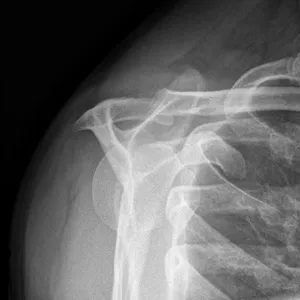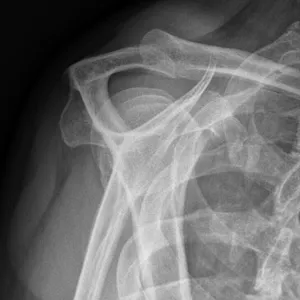Shoulder Center Saar
Extrinsic impingement of the shoulder
Extrinsic Impingement
This form of impingement syndrome is further divided into two subtypes: primary and secondary.
The classic impingement described by Neer is a subtype of primary extrinsic impingement. For a long time, primary extrinsic impingement was also referred to as outlet impingement.
The primary extrinsic or outlet impingement of the shoulder
…when bones press on the tendons.
In contrast, so-called outlet impingement results in a true constriction of the tendon.
One cause can be a congenital or acquired curvature of the acromion. Three different types of acromion are distinguished:
- Bigliani Type 1: The acromion rises obliquely upward. This ideal shape provides plenty of space for the humeral head and tendons.
- Bigliani Type 2: The acromion has a slight arched shape. The underlying structures are slightly constricted.
- Bigliani Type 3: The acromion is "hooked" in shape. A bone spur is located on the anterior acromion, which severely compresses and irritates the underlying tendons and bursae.

X-ray image of the type 2 acromion according to Bigliani

X-ray image of type 3 acromion according to Bigliani, clearly showing the hook shape with the large bone spur.
Non-outlet impingement of the shoulder or secondary extrinsic impingement:
- When the muscles no longer harmonize
The shoulder is a highly complex, muscularly controlled joint. Its function and stability depend largely on the proper cooperation of the surrounding muscles. The rotator cuff muscles, which surround the humeral head and stabilize it in the socket, are particularly important. These muscles ensure that the humeral head remains centered in various arm movements, thus preventing dislocation (dislocation) of the shoulder and impingement of tendons and bursae.
However, if the muscular balance is disturbed, the humeral head loses its precise centering in the socket. This often leads to the humeral head being pushed "upward and forward." In this malposition, tendons and bursae can be pushed under the shoulder roof, the so-called acromion, or the Coracoid process and become painfully trapped. Unlike other forms of impingement, which involve a structural narrowing of the shoulder space (for example, due to bony growths or calcifications), Non-outlet impingement from an entrapment without anatomical change or constriction of the tendon.
Causes and mechanisms
Non-outlet impingement is typically the result of muscular imbalance. In this case, the rotator cuff muscles, which normally work together in a finely tuned manner, are no longer able to optimally position the humeral head. This can be caused by several factors:
- Muscle fatigue or Weakness, especially the rotator cuff, which can be weakened by overload, inadequate training or injury.
- Muscle shortening or tension that leads to misalignment of the shoulder joint.
- Shoulder blade dysfunction(scapular dyskinesia), in which the shoulder blade no longer functions correctly with the humeral head. This can lead to a faulty movement chain and thus to overloading of the shoulder structures.
Current studies and findings
Recent research has shown that muscular balance and rotator cuff function are crucial for the prevention and treatment of non-outlet impingements. Studies show that targeted strengthening and stretching of the affected muscle groups can significantly reduce the risk of such impingements. In particular, strengthening the external rotators and the subscapularis muscle is considered particularly important to restore the correct positioning of the humeral head and thus prevent the entrapment of soft tissue.
A 2021 study examined the effect of a targeted Shoulder stabilization program on patients with non-outlet impingement. It was found that after a multi-week training program, both shoulder pain and function improved significantly. Participants demonstrated better centration of the humeral head and a reduction in impingement symptoms, highlighting the importance of muscular control for shoulder stability.
The concept ofScapula control is increasingly coming into focus. Studies indicate that scapular dysfunction is frequently associated with non-outlet impingement. Specific exercises that improve scapular control and mobility can optimize the biomechanical loading of the shoulder and reduce impingement symptoms.
Clinical significance
Non-outlet impingement is challenging for physicians and physical therapists because there are no obvious structural changes visible on X-rays or MRIs. Diagnosis therefore requires a thorough understanding of the muscular and biomechanical processes of the shoulder. Imaging techniques such as Ultrasonic or MRIcan be helpful in assessing muscular and tendon structures to detect accompanying injuries such as small tendon tears or inflammation.
However, the key to successful treatment lies in a comprehensive muscular rehabilitation. Physical therapy, which aims to strengthen the rotator cuff and improve scapular control, is the preferred treatment option. Surgery is rarely necessary for non-outlet impingements and is usually only considered in treatment-resistant cases.
In summary, non-outlet impingement is primarily caused by muscular imbalance, resulting in malalignment of the humeral head and painful entrapment of tendons and bursae. Clinical tests and imaging techniques play an important role in diagnosis, but treatment typically focuses on physical therapy to restore muscular control and normalize shoulder function.



